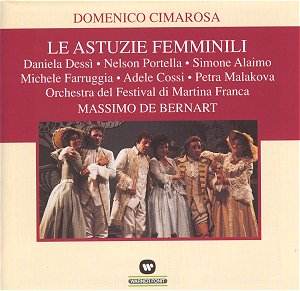Occasionally one listens to a disc which can only be
described as "fun". That could be because of different specific
aspects, or, as here, because it is the whole ambience. The cast sound
as if they are enjoying themselves and the orchestra is enthusiastic and
entertaining. The libretto and music can only described as written to
provide ‘light’ entertainment.
Whilst the music may be ‘light’ nevertheless there
are moments of excellent lyricism. It was Stendhal who would be hanged
before choosing his preference between Mozart and Cimarosa. To our twenty
first century ears a comparison may be made, but Mozart would be the
unhesitating choice. Certainly that is the position if judged by the
number of performances over the last one hundred years.
Take this comparison just a little further. How would
you translate Così fan tutte (first performed 1790). And what
offers would you make for Le Astuzie Femminili (first performed 1794)?
Unbelievable disguises are the key plot elements of both operas. There
the similarity ends for Cimarosa’s librettist Giuseppe (sometimes called
Giovanni) Palomba was not intent on proving anything to anyone. The
disguise element appeared in many of Cimarosa’s operas: not so with
Mozart and nor with Cimarosa’s most popular /performed opera Il Matrimonio
Segreto.
The performance history of this opera is reviewed in
the translation of the notes in the accompanying booklet. There is also
an accurate review of the libretto with a commentary on its strengths
and weaknesses and with observations on the strengths (not weaknesses)
of Cimarosa’s composition. One strength not mentioned which gives spontaneity
to much of the work is his disregard for consistent musical structure.
Further if a different tempo is required then that appears instantly
and so the vehicle of fun is provided; which is seized here.
That is particularly true of the orchestral support
which gives the singers a splendid foundation. There is no evident taut
control by De Bernart but on closer listening the control is there but
with a deft touch so the spontaneity of the performance is not lost.
Sometimes, but only sometimes, the tempo change is a little like waiting
for the clock to strike, but for the most part fluidity is ever present.
Neither a synopsis of the opera, nor a translation
(nor pagination) of the libretto are provided. However the extensive
commentary on the characters, their roles and high musical moments perhaps
make the former superfluous, while the omission of the latter is somewhat
of a disappointment. We will skip that and pick up the point made in
the notes that "the central figure in the opera is Don Giampaolo…who…risks
stealing the show". I am sure that is correct in performance and
while apparent on the CD the other potential show stealer must be Dottor
Romualdo sung here by the mellifluous tones of Simone Alaimo. His colourful
singing and excellent vocal contrasts coupled with superb diction put
him forward strongly as the CD "stealer".
Curiously Nelson Portella as Giampaola is a strongly
entertaining musical character given the "hummable "arias
– perhaps the best two – but whose "buffa" character does
not come through quite so strongly on the CD as it would on stage. Gun
waving mayhem and the like really needs visual support to vocal fun
to "steal" a show. All that said Portella sings the role superbly.
Here is a true opera buffa stereotype drawn well and sung even better.
That is particularly so in his interplay with Bellina,
sung by Daniela Dessì. She sounds happiest in the ensembles.
Which is hardly surprising because a love-lorn soprano heroine told
in a will that she will only inherit if she marries another is not going
to be a bundle of fun with her tenor hero sung by Michele Farruggia.
But her first aria/duet Addio per sempre… with him as with the
later duet Un palpito atroce… is a total pleasure. They achieve
an excellently mutually supportive balance.
Michele Farruggia seems to take time to find total
vocal comfort in his role. Early on loud and soft are not quite enough
but as he moves on, particularly in his "disguised" voice,
tonal variation comes forth and colourful contrast appears.
Our reliable notes tell us that both the supporting
roles are entrusted with musical treasures. Adele Cossi, given an aria
described as "half lyrical/half playful" seems not to know
that and fails to bring out sufficiently strongly either quality. There
is also a suspicion of off-key notes at one or two points. Petra Malakova
has an aria "of Mozartian grace" and she rises to the occasion
– just. Elsewhere there is no such doubt and her vocal skills are displayed
fully in her supporting role.
That is the analysis. But who wants to analyse something
that will cause you to smile if not laugh out loud: and when did you
last do that when listening to opera? This is opera buffa on stage:
so the singing voice moves across the stage and you can hear that; the
Russian ballet sounds more like a clog dance that a ballet; there is
a very occasional irritating audience noise. So what? This is great
entertainment and for £18.95 you will receive more than your money’s
worth of fun.
Robert McKechnie
